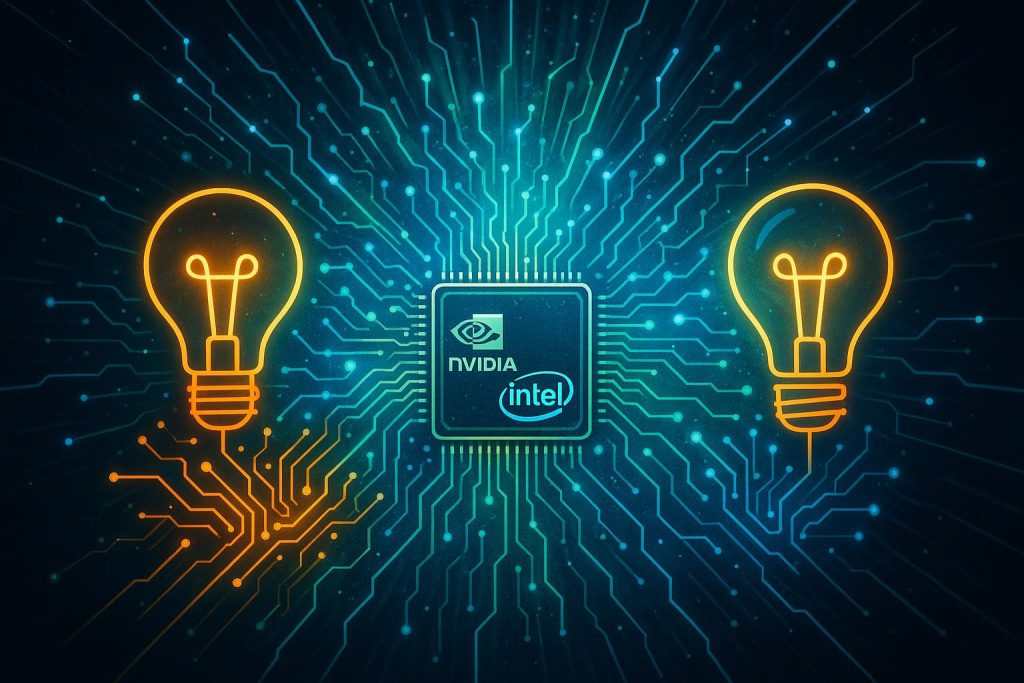Listen to the article
Nvidia announces a $5 billion investment in Intel, forging a strategic partnership to co-design processors and strengthen their positions in AI and data centre markets, disrupting traditional chip industry alliances.
Nvidia has announced a substantial $5 billion investment in Intel, marking a significant strategic alliance between the two tech giants. The move is seen as a major endorsement of Intel, which has been facing challenges in recent years. Nvidia’s purchase price for Intel stock is set at $23.28 per share, slightly below Intel’s recent closing price but above the $20.47 that the US government paid for a 10% stake in Intel earlier this year. Following the transaction, Nvidia is expected to hold at least 4% of Intel’s shares, becoming one of its largest shareholders.
This partnership extends beyond investment to joint development, as Intel and Nvidia plan to co-design custom processors for PCs and data centres. Nvidia’s chips, renowned for powering advances in artificial intelligence (AI), will be combined with Intel’s central processing units (CPUs) using proprietary technology that enables faster communication between the chips. This integration aims to enhance performance in AI applications, where chip-to-chip speed is critical for processing vast data sets. For the consumer market, Intel will receive custom Nvidia graphics chips to package alongside its PC CPUs, potentially strengthening Intel’s competitive position against rivals such as AMD.
Intel’s contract manufacturing business—or foundry—however, will not be involved in producing Nvidia’s chips under this deal. Analysts generally agree that Intel’s foundry business needs a major customer like Nvidia or Apple to thrive, and this deal stops short of that crucial foundry relationship. Nvidia’s ongoing reliance on Taiwan Semiconductor Manufacturing Company (TSMC) for its flagship processors remains a key factor, and TSMC may face competitive pressures if Nvidia’s collaboration with Intel evolves further.
The timing of this arrangement coincides with Intel’s recent financial bolstering, including the $5.7 billion US government investment and a $2 billion infusion from other sources. This capital boost comes as Intel plans to focus on new manufacturing technologies, including its next-generation 14A chip process. Intel’s new CEO, Lip-Bu Tan, hired earlier this year, has pledged a more disciplined approach to capacity building, aligning production more closely with demand.
Nvidia CEO Jensen Huang described the investment and alliance as an “incredible investment,” following nearly a year of discussions. He highlighted the strategic importance of the collaboration, noting that Nvidia is already a significant customer for Intel CPUs and a key supplier of GPU components for Intel’s chips. Huang emphasised that the partnership tightly integrates Nvidia’s AI and accelerated computing technology with Intel’s x86 CPU platform, which still commands a majority market share despite recent setbacks in both data center and PC chips. The combined effort could pose a serious challenge to AMD and Broadcom, who are competing in the AI server and chip interconnect space.
Though the companies have not disclosed specific financial terms of their technical collaboration beyond the stock purchase, they indicated plans to develop multiple generations of co-engineered products. They also clarified that the arrangement is a commercial partnership without licensing components, and current product plans leading up to the deal remain unchanged. The timeline for the first products to reach market has not been provided.
This alliance reflects a broader landscape of shifting alliances and investments in the semiconductor sector, where securing advanced manufacturing and AI capability is crucial to future competitiveness. Nvidia’s move to invest heavily in Intel signals confidence in the long-term potential of Intel’s technology and manufacturing roadmap, even as Intel faces ongoing market pressures. Meanwhile, competitors such as AMD and TSMC will be closely watching how this partnership unfolds, given its possible implications for chip supply chains and the AI hardware market.
📌 Reference Map:
- Paragraph 1 – [1], [3], [5], [7]
- Paragraph 2 – [1], [3], [5], [7]
- Paragraph 3 – [1], [3], [5], [7]
- Paragraph 4 – [1], [3], [5], [7]
- Paragraph 5 – [1], [2], [4], [6]
- Paragraph 6 – [1], [2], [4], [6]
- Paragraph 7 – [1], [3], [5], [7]
Source: Noah Wire Services



